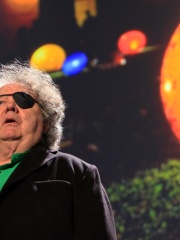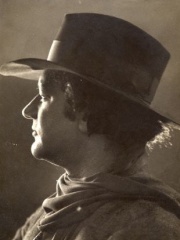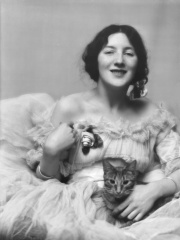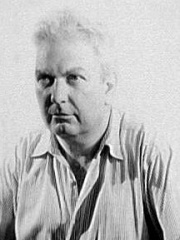
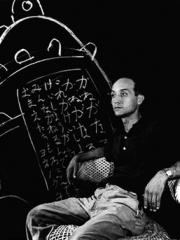
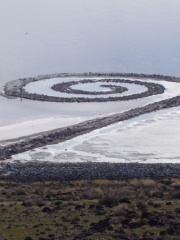
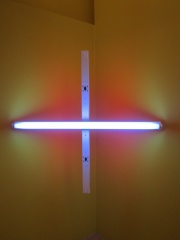
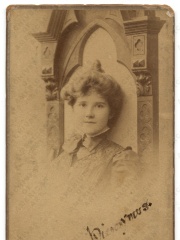
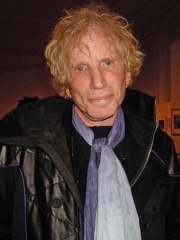
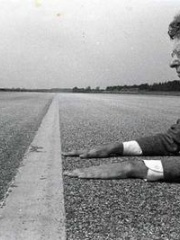
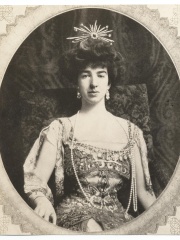
The Most Famous
SCULPTORS from United States
This page contains a list of the greatest American Sculptors. The pantheon dataset contains 258 Sculptors, 22 of which were born in United States. This makes United States the birth place of the 3rd most number of Sculptors behind France, and Italy.
Top 10
The following people are considered by Pantheon to be the top 10 most legendary American Sculptors of all time. This list of famous American Sculptors is sorted by HPI (Historical Popularity Index), a metric that aggregates information on a biography's online popularity. Visit the rankings page to view the entire list of American Sculptors.

1. Alexander Calder (1898 - 1976)
With an HPI of 71.36, Alexander Calder is the most famous American Sculptor. His biography has been translated into 48 different languages on wikipedia.
Alexander "Sandy" Calder (; July 22, 1898 – November 11, 1976) was an American sculptor known both for his innovative mobiles (kinetic sculptures powered by motors or air currents) that embrace chance in their aesthetic, his static "stabiles", and his monumental public sculptures. Calder preferred not to analyze his work, saying, "Theories may be all very well for the artist himself, but they shouldn't be broadcast to other people." His father, Alexander Stirling Calder, and grandfather, Alexander Milne Calder, were also sculptors.

2. Isamu Noguchi (1904 - 1988)
With an HPI of 64.79, Isamu Noguchi is the 2nd most famous American Sculptor. His biography has been translated into 27 different languages.
Isamu Noguchi (野口 勇, Noguchi Isamu; Japanese: [noꜜgɯtɕi isamɯ], English: ; November 17, 1904 – December 30, 1988) was an American artist, furniture designer and landscape architect whose career spanned six decades from the 1920s. Known for his sculpture and public artworks, Noguchi also designed stage sets for various Martha Graham productions, and several mass-produced lamps and furniture pieces, some of which are still manufactured and sold. In 1947, Noguchi began a collaboration with the Herman Miller company, when he joined with George Nelson, Paul László and Charles Eames to produce a catalog containing what is often considered to be the most influential body of modern furniture ever produced, including the iconic Noguchi table which remains in production today. His work is displayed at the Isamu Noguchi Foundation and Garden Museum in New York City.

3. Robert Smithson (1938 - 1973)
With an HPI of 64.11, Robert Smithson is the 3rd most famous American Sculptor. His biography has been translated into 28 different languages.
Robert Smithson (January 2, 1938 – July 20, 1973) was an American artist known for sculpture and land art who often used drawing and photography in relation to the spatial arts. His work has been internationally exhibited in galleries and museums and is held in public collections. He was one of the founders of the land art movement whose best known work is the Spiral Jetty (1970).

4. Dan Flavin (1933 - 1996)
With an HPI of 60.25, Dan Flavin is the 4th most famous American Sculptor. His biography has been translated into 22 different languages.
Dan Flavin (April 1, 1933 – November 29, 1996) was an American minimalist artist famous for creating sculptural objects and installations from commercially available fluorescent light fixtures.

5. Robert Morris (1931 - 2018)
With an HPI of 59.82, Robert Morris is the 5th most famous American Sculptor. His biography has been translated into 23 different languages.
Robert Morris (February 9, 1931 – November 28, 2018) was an American sculptor, conceptual artist and writer. He was regarded as having been one of the most prominent theorists of Minimalism along with Donald Judd, but also made important contributions to the development of performance art, land art, the Process Art movement, and installation art. Morris lived and worked in New York. In 2013 as part of the October Files, MIT Press published a volume on Morris, examining his work and influence, edited by Julia Bryan-Wilson.

6. Anna Coleman Ladd (1878 - 1939)
With an HPI of 59.65, Anna Coleman Ladd is the 6th most famous American Sculptor. Her biography has been translated into 21 different languages.
Anna Coleman Watts Ladd (July 15, 1878 – June 3, 1939) was an American sculptor who traveled around the world in order to hone her skills. She is most well-known for her contributions to war efforts during World War I, but she was an accomplished sculptor, author, and playwright before the war began. She called many places home throughout her lifetime, including Pennsylvania, Boston, Rome, Paris, and California.

7. Dennis Oppenheim (1938 - 2011)
With an HPI of 59.11, Dennis Oppenheim is the 7th most famous American Sculptor. His biography has been translated into 22 different languages.
Dennis Oppenheim (September 6, 1938 – January 21, 2011) was an American conceptual artist, performance artist, earth artist, sculptor and photographer. Oppenheim's early artistic practice was an epistemological survey of art that responded to the strategies of the Minimalists that expanded to focus on site and context. His work progressed from perceptions of the physical properties of the gallery to the social and political context.

8. Walter De Maria (1935 - 2013)
With an HPI of 58.76, Walter De Maria is the 8th most famous American Sculptor. His biography has been translated into 20 different languages.
Walter Joseph De Maria (October 1, 1935 – July 25, 2013) was an American artist, sculptor, illustrator and composer, who lived and worked in New York City. Walter de Maria's artistic practice is connected with minimal art, conceptual art, and land art of the 1960s. LACMA director Michael Govan said, "I think he's one of the greatest artists of our time." Govan, who worked with De Maria for a number of years, found De Maria's work "singular, sublime and direct".

9. Gertrude Vanderbilt Whitney (1875 - 1942)
With an HPI of 57.06, Gertrude Vanderbilt Whitney is the 9th most famous American Sculptor. Her biography has been translated into 19 different languages.
Gertrude Vanderbilt Whitney (January 9, 1875 – April 18, 1942) was an American sculptor, art patron and collector, and founder in 1931 of the Whitney Museum of American Art in New York City. She was a prominent social figure and hostess, who was born into the wealthy Vanderbilt family and married into the Whitney family.
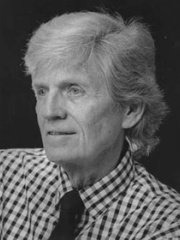
10. Duane Hanson (1925 - 1996)
With an HPI of 56.72, Duane Hanson is the 10th most famous American Sculptor. His biography has been translated into 15 different languages.
Duane Hanson (January 17, 1925 – January 6, 1996) was an American artist and sculptor born in Minnesota. He spent most of his career in South Florida. He was known for his life-sized realistic sculptures of people. He cast the works based on human models in various materials, including polyester resin, fiberglass, Bondo, and bronze. His sculptures often provided political-social commentary and satire. Hanson's works are in the permanent collections of The Whitney Museum of American Art, The San Francisco Museum of Modern Art, and The Smithsonian.
People
Pantheon has 22 people classified as American sculptors born between 1805 and 1946. Of these 22, 1 (4.55%) of them are still alive today. The most famous living American sculptors include Dale Chihuly. The most famous deceased American sculptors include Alexander Calder, Isamu Noguchi, and Robert Smithson.
Living American Sculptors
Go to all RankingsDeceased American Sculptors
Go to all RankingsAlexander Calder
1898 - 1976
HPI: 71.36
Isamu Noguchi
1904 - 1988
HPI: 64.79
Robert Smithson
1938 - 1973
HPI: 64.11
Dan Flavin
1933 - 1996
HPI: 60.25
Robert Morris
1931 - 2018
HPI: 59.82
Anna Coleman Ladd
1878 - 1939
HPI: 59.65
Dennis Oppenheim
1938 - 2011
HPI: 59.11
Walter De Maria
1935 - 2013
HPI: 58.76
Gertrude Vanderbilt Whitney
1875 - 1942
HPI: 57.06
Duane Hanson
1925 - 1996
HPI: 56.72
Jacob Epstein
1880 - 1959
HPI: 56.52
Audrey Munson
1891 - 1996
HPI: 56.39
Overlapping Lives
Which Sculptors were alive at the same time? This visualization shows the lifespans of the 21 most globally memorable Sculptors since 1700.

